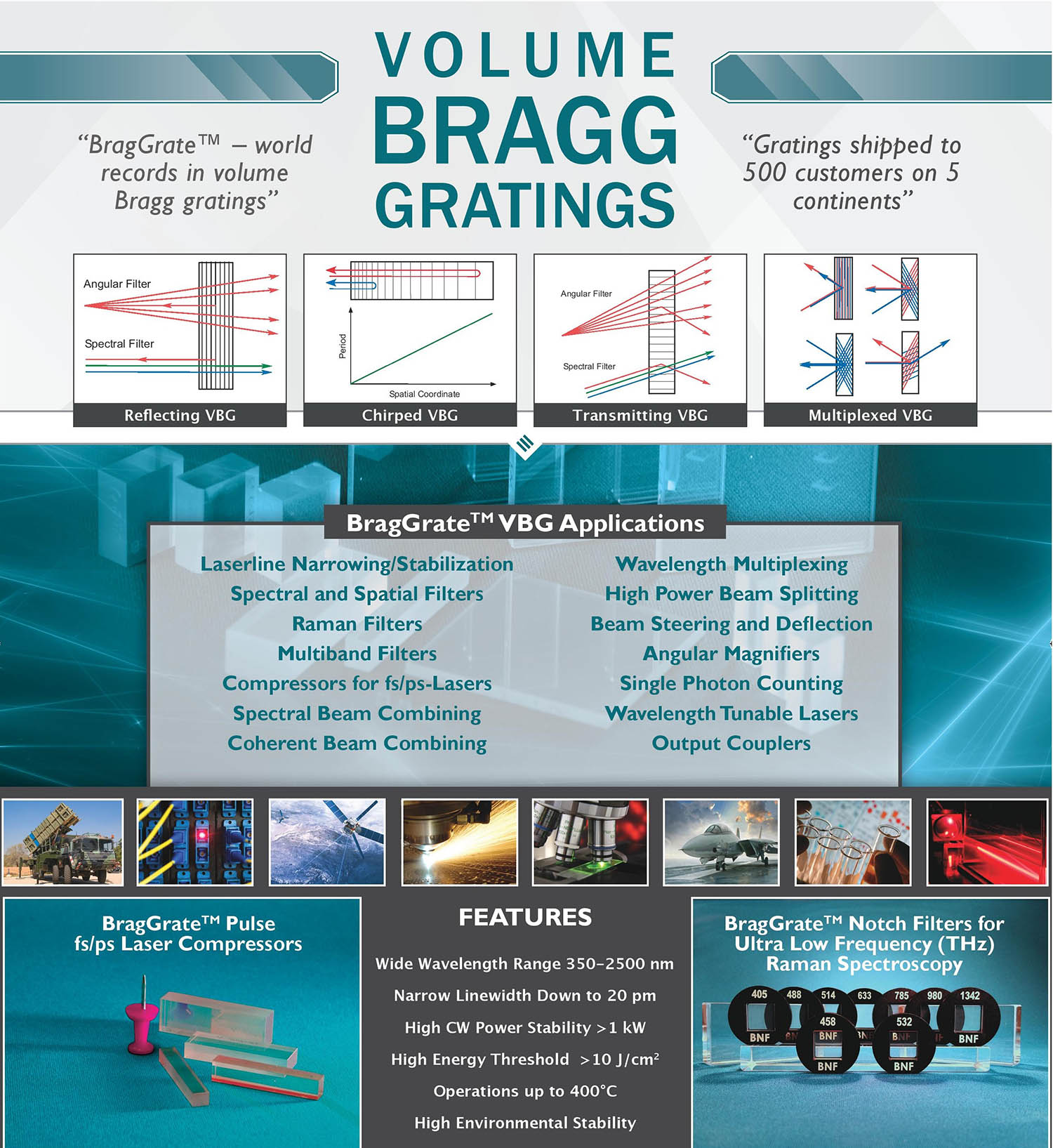Lasers
A new type of longitudinal mode selector for solid state lasers was demonstrated at OptiGrate in late 1990’s. This approach was based on intra-cavity mode selection by volume Bragg gratings (VBG) recorded in photo-thermo-refractive (PTR) glass. This type of reflecting VBG’s currently constitutes BragGrate™ mirror product line at OptiGrate. Unique properties of BragGrate™ mirrors in PTR glass, such as high laser damage threshold and unrestricted life time, pave the way for various laser applications of these holographic optical elements. These gratings can have spectral selectivity as narrow as 20 pm and angular selectivity below 1 mrad. Various types of lasers with intra-cavity BragGrate™ mirrors were demonstrated with an efficient selection of transverse and longitudinal modes. The use of BragGrate™ mirrors as output couplers for CW and pulsed solid state and semiconductor lasers has shown narrowing and stabilization of laser emission spectra without a decrease in output power.
Spectroscopy
Outstanding spectral and angular selection properties of BragGrate™ optical elements make them very useful for a number of spectroscopy applications, specifically for Raman spectroscopy.
- Spectral stabilization of Raman laser diode sources with BragGrate™ mirrors. Stabilized laser diode Raman sources provide a viable and cost effective alternative to more traditional in Raman spectroscopy solid state lasers.
- Amplified Spontaneous Emission (ASE) Filters can be used with spectrally stabilized laser diode sources to suppress the ASE by many orders of magnitude.
- BragGrate™ notch filters formed from high efficiency RBG’s provide an ultra-narrow line filtering capabilities with the line width narrower than 5 cm-1 at FWHM. They enable simultaneous measurements of Stokes and anti-Stokes Raman bands in the low THz frequency range (0.2-5 THz) with single stage spectrometers.
- BragGrate™ Deflectors formed from high efficiency TBG’s allow spectral selection of narrow lines for spectral sensor applications.
Stretchers and Compressors
Continuous development of CBG technology at OptiGrate resulted in a demonstration of BragGrate Pulse elements for ultra-short pulse stretchers and compressors with a bandwidth up to 27 nm and absolute diffraction efficiency exceeding 90%. The improvements in CBG technology secured a nearly diffraction limited quality of a beam after stretching and compression. Compact CPA systems with 100 W of average power, 180 fs pulse duration at 1060 nm and a record 10 W of average power at 1550 nm were demonstrated in 2008.
Angular Magnification
The general principle is a spatial combination of a set of spectrally shifted beams by transmitting or reflecting BragGrate™ elements which strongly diffracts a narrow range of wavelengths and transmits surrounding bands. The new combined wavelengths are adding sequentially; each BragGrate™ element has to be tuned to transmit wavelengths already in the beam and reflect the wavelength being added. A new power record by combining of five continuous-wave ytterbium-fiber laser beams to produce more than 750 W in a single near-diffraction-limited beam was set in 2008 by four large-aperture BragGrate™ Combiners.
Spectral Beam Combining
Transmitting Bragg gratings or BragGrate™ Deflectors can be used for 2D or 3D beam steering or non-mechanical angular magnification. Recent experiments conducted in collaboration with Fujitsu Ltd demonstrated a capability of planar integrated BragGrate™ Deflectors to enhance the deflection angle more than 5 times in ultrafast electro-optic non-mechanical cross-connect switches. High power and energy tolerance of BragGrate™ Deflectors enable unmatched possibilities for applications of such holographic optical elements for steering of high power laser beams.

